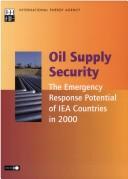| Listing 1 - 2 of 2 |
Sort by
|

ISBN: 1280035595 9786610035595 9264188460 9264185755 Year: 2001 Publisher: Paris Organisation de Coopération et de Développement économiques
Abstract | Keywords | Export | Availability | Bookmark
 Loading...
Loading...Choose an application
- Reference Manager
- EndNote
- RefWorks (Direct export to RefWorks)
Every five years, the International Energy Agency publishes an exhaustive report on its Member countries’ preparations to respond to major oil supply disruptions. This review, the first since 1996, finds strong legislative frameworks and administrative structures in each IEA country. Most countries have oil stocks well above the 90 days of net oil imports to which they are committed. IEA countries also have viable demand restraint programmes. Weaknesses in national programmes have been identified and will be corrected. The review provides a complete overview of emergency response potential agency-wide. It also contains detailed country-by-country analyses for 28 countries, including the Czech Republic, the newest IEA member, and the candidate countries Poland, Korea and the Slovak Republic. In each case, an assessment is made of the main emergency response measures, including stockdraw, demand restraint, fuel switching, extra oil production and the sharing of oil supplies. A separate section presents the legislative and regulatory texts underlying each country programme. The IEA was founded in 1974 following the oil shock of 1973. Its main initial objective was to ensure an effective response to any further oil disruption. While much has changed in 26 years, safeguarding the energy security of its Members remains a core mission for the Agency.
Petroleum industry and trade --- Petroleum reserves --- National security --- Business & Economics --- Industries --- Government policy --- International cooperation --- National security policy --- NSP (National security policy) --- Security policy, National --- Oil reserves --- Oil supply --- Petroleum --- Petroleum supply --- Reserves of petroleum --- Reserves --- Economic policy --- International relations --- Military policy --- Oil fields --- Government policy. --- International cooperation. --- Pétrole --- Industrie et commerce --- Réserves --- Coopération internationale
Book
ISBN: 9461663099 9789461663092 9789461663108 9461663102 9789462702004 9462702004 Year: 2020 Publisher: Leuven University Press
Abstract | Keywords | Export | Availability | Bookmark
 Loading...
Loading...Choose an application
- Reference Manager
- EndNote
- RefWorks (Direct export to RefWorks)
Large quantities of oil were discovered in the Albertine Rift Valley in Western Uganda in 2006. The sound management of these oil resources and revenues is undoubtedly one of the key public policy challenges for Uganda as it is for other African countries with large oil and/or gas endowments. With oil expected to start flowing in 2021, the current book analyses how this East African country is preparing for the challenge of effectively, efficiently, and transparently managing its oil sector and resources. Adopting a multidisciplinary, comprehensive, and comparative approach, the book identifies a broad scope of issues that need to be addressed in order for Uganda to realise the full potential of its oil wealth for national economic transformation. Predominantly grounded in local scholarship and including chapters drawing on the experiences of Nigeria, Ghana, and Kenya, the book blazes a trail on governance of African oil in an era of emerging producers. Oil Wealth and Development in Uganda and Beyond will be of great interest to social scientists and economic and social policy makers in oil-producing countries. It is suitable for course adoption across such disciplines as International/Global Affairs, Political Economy, Geography, Environmental Studies, Economics, Energy Studies, Development, Politics, Peace, Security and African Studies.
Social impact of environmental issues.
---
Environmental policy & protocols.
---
Environmental management.
---
Energy industries & utilities.
---
Energy & natural resources law.
---
Development economics & emerging economies.
---
Petroleum industry and trade
---
Petroleum reserves
---
620.9
| Listing 1 - 2 of 2 |
Sort by
|

 Search
Search Feedback
Feedback About UniCat
About UniCat  Help
Help News
News